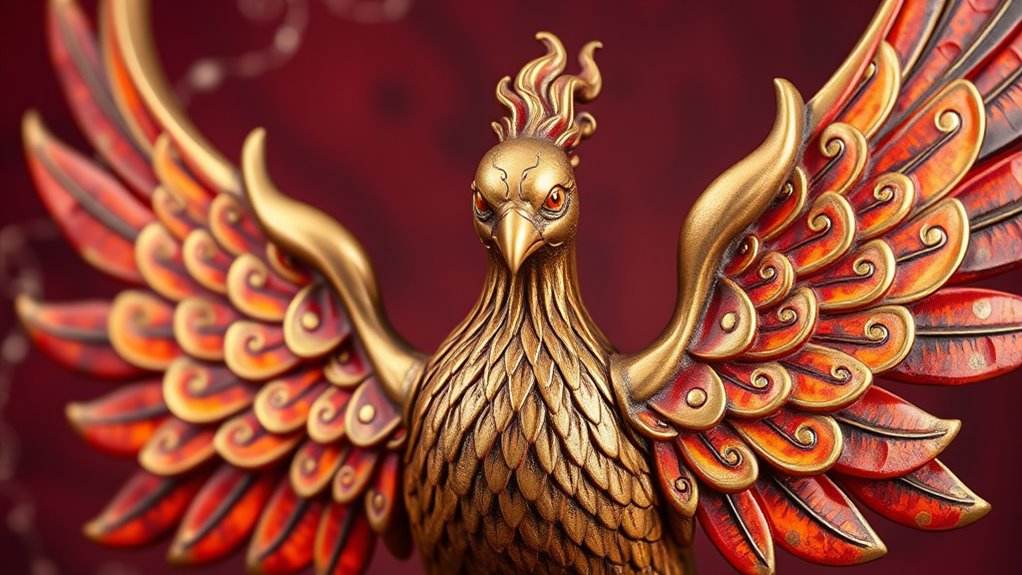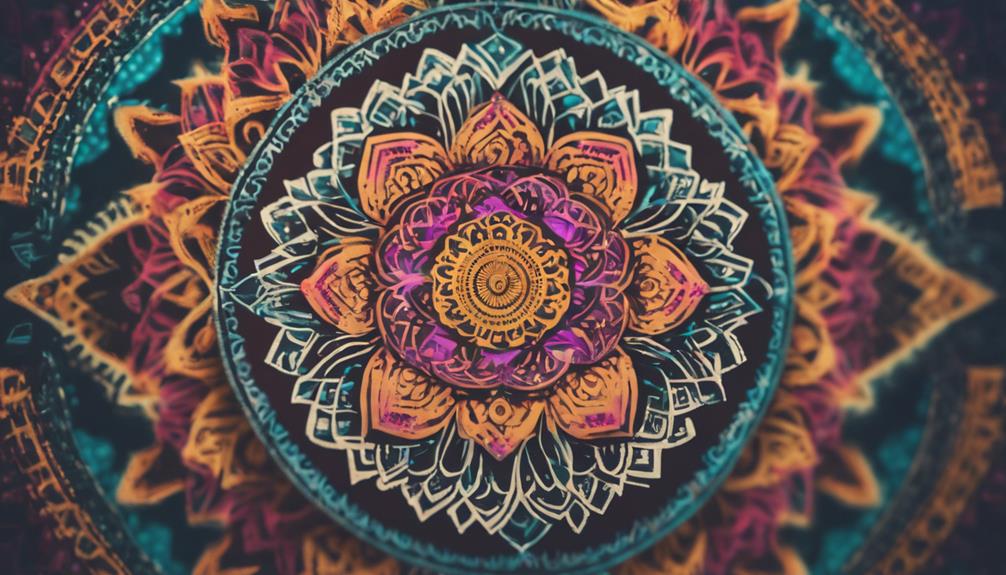In decorative art, the phoenix symbolizes renewal, resilience, and rebirth, with roots in ancient Egyptian mythology where it represents immortality. Artists often depict it with fiery plumage and dynamic poses to evoke transformation and hope. The motif appears in jewelry, architecture, mosaics, and sculptures, serving as a visual reminder of rising from adversity. If you continue exploring, you’ll discover how this powerful emblem has inspired countless creative expressions across cultures and eras.
Key Takeaways
- The phoenix symbolizes rebirth and renewal, originating from ancient Egyptian mythology and adopted by Greek and Roman cultures.
- Artistic representations often feature fiery plumage with bold reds, golds, and oranges, emphasizing flames and upward movement.
- In decorative arts, the phoenix appears in jewelry, mosaics, and architecture, symbolizing eternal life and spiritual transformation.
- Its imagery embodies resilience, cyclical renewal, and overcoming adversity across various cultural and historical contexts.
- Modern art continues to use the phoenix as a universal emblem of hope, renewal, and new beginnings amidst destruction.

Have you ever noticed the striking image of a phoenix in decorative art? This legendary bird, often depicted rising from its own ashes, captures your attention with its vibrant feathers and dynamic posture. Its presence in various artistic works isn’t accidental; it’s rooted in rich mythological origins that have fascinated cultures for centuries. The phoenix’s myth began in ancient Egypt, where it symbolized rebirth, immortality, and renewal. Later, stories from Greek and Roman traditions adopted and adapted this myth, portraying the phoenix as a creature that periodically regenerates itself through fire. These mythological origins give the phoenix a profound meaning, making it a powerful motif in decorative art that resonates with themes of transformation and hope.
The phoenix symbolizes rebirth and renewal, rooted in ancient Egyptian, Greek, and Roman mythologies.
In artistic representations, you’ll notice that the phoenix is often illustrated with fiery plumage, wings spread wide as if about to take flight. Artists love to emphasize the creature’s majestic and fiery aspects, using bold colors like gold, red, and orange to evoke the flames associated with its rebirth. Whether depicted in ancient mosaics, illuminated manuscripts, or modern sculptures, the phoenix’s image consistently symbolizes renewal. Its upward motion, often captured in dynamic poses, embodies the idea of overcoming adversity and emerging stronger. These artistic representations aren’t just decorative; they serve as visual metaphors for resilience and the cyclical nature of life.
The way the phoenix appears in decorative art also varies across cultures and eras. In some cases, it’s integrated into intricate jewelry, symbolizing eternal life and spiritual transformation. In others, it’s part of grand architectural motifs, signifying rebirth on a communal level. Artists frequently use the mythological origins of the phoenix to craft elaborate patterns that highlight its mythic stature. They incorporate flowing lines, flames, and celestial elements to elevate the creature from mere ornamentation to a symbol of enduring hope and renewal. The recurring theme is clear: no matter the medium or style, the phoenix’s artistic representations always evoke a sense of rising anew from destruction.
When you see a decorative piece featuring a phoenix, you’re witnessing more than just a bird; you’re engaging with a symbol deeply embedded in human history and imagination. Its mythological origins give it significance beyond aesthetics, making it a universal emblem of rebirth. Artists continue to draw inspiration from this legendary creature, ensuring that its powerful message endures through the ages. Whether as a small decorative motif or a central feature in a grand artwork, the phoenix remains a compelling reminder that even in destruction, there’s always the potential for renewal and new beginnings.
Frequently Asked Questions
How Did the Phoenix Become a Symbol of Rebirth in Different Cultures?
You see, the phoenix became a symbol of rebirth through its mythical symbolism of renewal and immortality. Across cultural variations, it’s associated with cycles of death and resurrection, reflecting hope and transformation. In Ancient Egypt, it represented the sun’s daily rebirth, while in Greece, it symbolized eternal life. These diverse interpretations help the phoenix stand as a powerful emblem of renewal in many societies worldwide.
Are There Specific Materials Used in Phoenix-Inspired Decorative Art?
You’ll notice that phoenix-inspired decorative art often uses materials like metal accents and glass mosaics to evoke its fiery, majestic nature. Metal accents highlight the bird’s feathers and flames, adding shimmer and texture, while glass mosaics create vibrant, dynamic surfaces that capture the phoenix’s rebirth symbolism. These materials emphasize the phoenix’s fiery rebirth, making the artwork striking and meaningful, perfect for celebrating renewal and transformation.
What Are the Most Famous Artworks Featuring the Phoenix Motif?
You’ll recognize famous artworks featuring the phoenix motif like Botticelli’s “The Birth of Venus” and the intricate stained glass windows of Chartres Cathedral, where mythical symbolism elevates artistic interpretations. These masterpieces juxtapose divine rebirth with earthly beauty, highlighting the phoenix’s enduring influence. Their vibrant depictions celebrate renewal, making them some of the most iconic representations of this mythic creature in decorative art history.
How Has the Phoenix Symbol Evolved Over History in Decorative Arts?
You see the phoenix symbol evolve from mythical narratives to a powerful motif in decorative arts. Over history, artists have used it to represent renewal, immortality, and resilience, adapting its imagery across cultures and styles. Its artistic symbolism becomes more stylized, blending with other motifs or emphasizing its fiery rebirth. This evolution highlights how the phoenix continues to inspire, embodying hope and transformation in various decorative objects and artworks.
Can the Phoenix Represent Concepts Beyond Rebirth, Like Immortality or Renewal?
Yes, the phoenix can symbolize concepts beyond rebirth, like immortality symbolism and renewal themes. When you see a phoenix in decorative art, it often represents eternal life and continuous renewal, emphasizing resilience and the cycle of life. Its fiery imagery highlights enduring strength, making it a powerful symbol for overcoming adversity and embracing ongoing transformation, inspiring hope and perseverance in various cultural and artistic contexts.
Conclusion
As you admire the intricate designs featuring the phoenix, remember it’s more than just a bird—it’s a powerful symbol of renewal and resilience. Each time you see its fiery wings rise from ashes, you’re reminded that rebirth is always possible, even after the darkest moments. Let this timeless motif inspire you to embrace change and rise anew, just like the legendary phoenix. In its flames, find hope and the promise of a fresh start.









